03 January 2025 : Daily Current Affairs
1. Experts on GM crop panels to declare conflict of interest
- 1. Experts on GM crop panels to declare conflict of interest
- 2. Govt. report reveals stark infrastructure gap in Indian schools
- 3. Obesity: soft core of an epidemic of non-communicable diseases
- 4. Key Insights from ASUSE 2023-24
- 5. DAP (di-ammonium phosphate) BEYOND NBS SUBSIDY
- About Fertilizer subsidy in India
- Prelims Facts
- 1. RTO official’s Mongolia trip to click Pallas’s cat find its way into textbook
- 2. Indian researchers develop injectable hydrogel for targeted cancer treatment
- 3. Why has Trump called the Panama treaty ‘foolish’?
- 4. Uttarakhand Launches Winter Char Dham Circuit: Boosting Tourism Amid Environmental Concerns
- 5. Air India Introduces In-Flight Wi-Fi: A First for Domestic Airlines in India
- 6. Annual Ground Water Quality Report, 2024
- Key Highlights
- Reasons for groundwater contamination
- Government Initiatives
(Source – The Hindu, International Edition – Page No. – 6)
| Topic: GS2 – Governance, GS3 – Agriculture |
| Context |
|
Amendment to GEAC Rules
- Under the new rules, expert members are required to disclose any interests that might conflict with their duties.
- Experts must take measures to ensure that conflicts of interest do not influence the committee’s decisions.
| Genetic Engineering Appraisal Committee (GEAC) |
GEAC (Genetic Engineering Appraisal Committee) is a statutory body under the Environment (Protection) Act, 1986.
|
Conflict of Interest Provisions
- Expert members with direct or indirect associations with matters being discussed in committee meetings must disclose these associations prior to the meetings.
- Unless specifically requested by the committee, such members are expected to recuse themselves from the discussion.
- Selected members must submit a form detailing their professional affiliations over the past decade before joining the committee.
Supreme Court’s Order on GM Crops
- In July 2023, the Supreme Court directed the Centre to form a national policy on GM crops.
- The court delivered a split verdict on the Centre’s 2022 conditional approval for the environmental release of GM mustard.
- The court concurred on the need for a process to address conflict of interest issues.
Allegations of Conflict of Interest
- Allegations of conflict of interest in GM crop regulation arose in 2013.
- Activist group Coalition for GM-Free India alleged that a member of the Technical Expert Committee, appointed by the court, was associated with an organization funded by Monsanto, a major multinational biotech company.
| Conflict of interest and its potential implications: |
|
| Practice Question: Examine the potential implications of conflicts of interest in the decision-making process of regulatory bodies like the Genetic Engineering Appraisal Committee (GEAC), with specific reference to the regulation of genetically modified organisms in India. (250 Words /15 marks) |
2. Govt. report reveals stark infrastructure gap in Indian schools
(Source – The Hindu, International Edition – Page No. – 6)
| Context |
|
| Facility | Total Schools | Schools with Functional Facility | Schools without Functional Facility |
| Electricity | 14.71 lakh | 13.19 lakh | 1.52 lakh |
| Drinking Water | 14.71 lakh | 14.11 lakh | 67,000 |
| Toilet Facility | 14.71 lakh | 14.04 lakh | 67,000 |
Disabled-Friendly Facilities
- Only 3.37 lakh government schools have disabled-friendly toilets, highlighting inadequate provisions for differently-abled students.
- The condition of disabled-friendly facilities is notably poor in the majority of schools across India.
Conclusion
- This data highlights the gaps in basic infrastructure and facilities in schools, especially government-run ones, affecting the quality of education and student well-being.
| Practice Question: Examine the current status of basic infrastructure facilities such as electricity, drinking water, and toilets in schools in India, based on the latest UDISE+ data. Discuss the implications for education and the measures needed to address these gaps. (250 Words /15 marks) |
3. Obesity: soft core of an epidemic of non-communicable diseases
(Source – The Hindu, International Edition – Page No. – 7)
| Context |
|
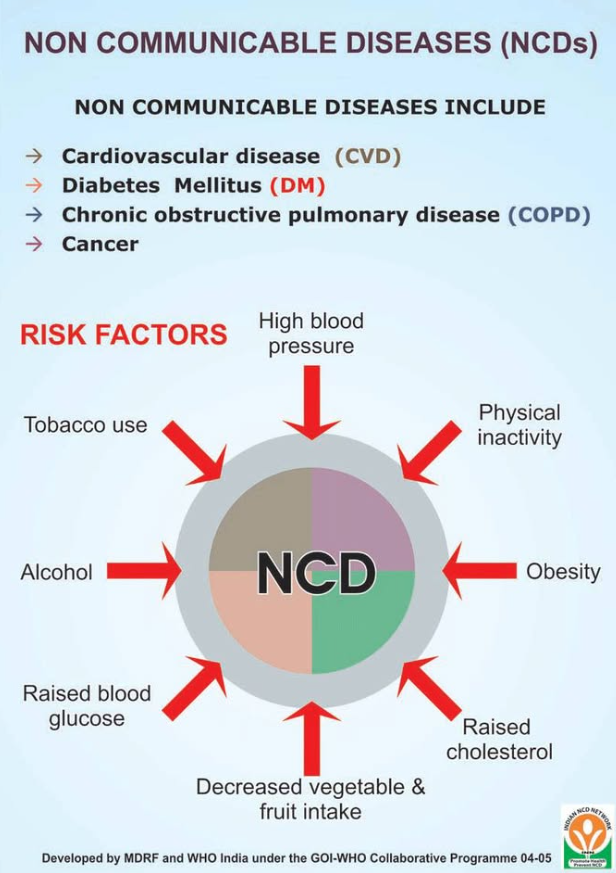
Obesity and Non-Communicable Diseases (NCDs)
- Obesity is a chronic disease characterized by excessive fat deposits that can harm an individual’s health.
- It significantly increases the risk of several NCDs, including diabetes, hypertension, heart disease, and certain cancers.
- Additionally, obesity impacts quality of life factors such as sleep, mobility, and mental well-being.
- Obesity has been identified as a soft core for the epidemic of NCDs, exacerbating other health problems, and leading to early mortality.
Global and Childhood Obesity
- The World Health Organization (WHO) states that one in eight people worldwide are obese, and one in three are overweight.
- Worldwide, obesity in adults has doubled since 1990, and adolescent obesity has quadrupled.
- As of now, 37 million children under five years are overweight, while 390 million children and adolescents aged 5-19 years are overweight, and 160 million are obese.
- Childhood obesity in India is a growing concern, with the country ranking second globally for the highest number of obese children.
- Factors contributing to childhood obesity include a lack of physical activity, high-calorie foods, sugary drinks, and genetic influences.
| The Indian Scenario |
|
Obesity and Its Impact
- Obesity causes 3.4 million deaths annually worldwide, and India ranks third after China and the USA in terms of obesity-related deaths.
- Beyond the medical costs, obesity has economic repercussions, including loss of productivity, absenteeism from work, and premature mortality.
- The psychological effects of obesity are severe, leading to low self-esteem, mood disorders, and poor body image.
Addressing Obesity
- Weight loss is critical in preventing and treating obesity-related NCDs. Even modest weight reduction can lead to reduced blood pressure, improved cholesterol levels, and reduced diabetes risk.
- Treatments for obesity include newer medications and bariatric surgery, though they come with high costs and side effects.
- Prevention and treatment also focus on lifestyle changes like regular physical activity and avoiding unhealthy food.
- Recommendations include 6,000-8,000 steps daily, avoiding lifts, walking instead of driving, and limiting screen time.
- Employers can support by setting walking targets for their employees, and individuals should monitor their weight and waist circumference regularly.
Conclusion
- Addressing obesity requires a multifaceted approach, including awareness, advocacy, medical treatments, and changes in lifestyle.
- Simple interventions like regular exercise, balanced diets, and reducing sedentary behavior can significantly help in managing obesity and its related NCDs.
| Practice Question: Discuss the role of obesity in the rise of non-communicable diseases. How can India address the growing obesity epidemic to improve public health? (150 Words /10 marks) |
4. Key Insights from ASUSE 2023-24
(Source – https://pib.gov.in/PressReleseDetail.aspx?PRID=2089569®=3&lang=1 )
| Topic: GS3 – Indian Economy |
| Context |
|
Sectoral Growth
- The unincorporated sector in India has shown substantial growth, with the number of establishments rising from 6.50 crore in 2022-23 to 7.34 crore in 2023-24, marking an impressive 12.84% increase.
- The “Other Services” sector led this growth with a significant 23.55% increase in the number of establishments, while the manufacturing sector saw a 13% rise.
- The Gross Value Added (GVA) of the sector, an important economic performance indicator, grew by 16.52%. This growth was primarily driven by the 26.17% increase in the “Other Services” sector.
Labour Market Expansion
- Employment in the unincorporated sector increased substantially, reaching over 12 crore workers in 2023-24, reflecting an addition of more than one crore workers compared to the previous year.
- Gender inclusivity improved, with the percentage of female-owned proprietary establishments rising from 22.9% in 2022-23 to 26.2% in 2023-24.
- The average emoluments per hired worker grew by 13%, indicating improved wage levels. The manufacturing sector experienced the highest wage growth at over 16%.
Labour Productivity
- Gross Value Added (GVA) per worker, a key measure of labour productivity, increased by 5.62%, rising from Rs. 1,41,769 in 2022-23 to Rs. 1,49,742 in 2023-24.
- Similarly, the Gross Value of Output (GVO) per establishment grew from Rs. 4,63,389 to Rs. 4,91,862, reflecting overall sectoral productivity improvements.
Digital Adoption
- Digital adoption among establishments saw a notable rise, with internet usage increasing from 21.1% in 2022-23 to 26.7% in 2023-24, highlighting the growing role of digital tools in business operations.
Conclusion
- The ASUSE 2023-24 results underscore the unincorporated sector’s significant contribution to India’s economic recovery, marked by growth in establishments, employment, productivity, and digital adoption.
| Practice Question: Discuss the recent trends and improvements observed in the unincorporated non-agricultural sector as highlighted by the Annual Survey of Unincorporated Sector Enterprises (ASUSE) 2023-24. (150 Words /10 marks) |
5. DAP (di-ammonium phosphate) BEYOND NBS SUBSIDY
| Topic: GS3 – Indian Economy |
| Context |
|
Analysis of the news:
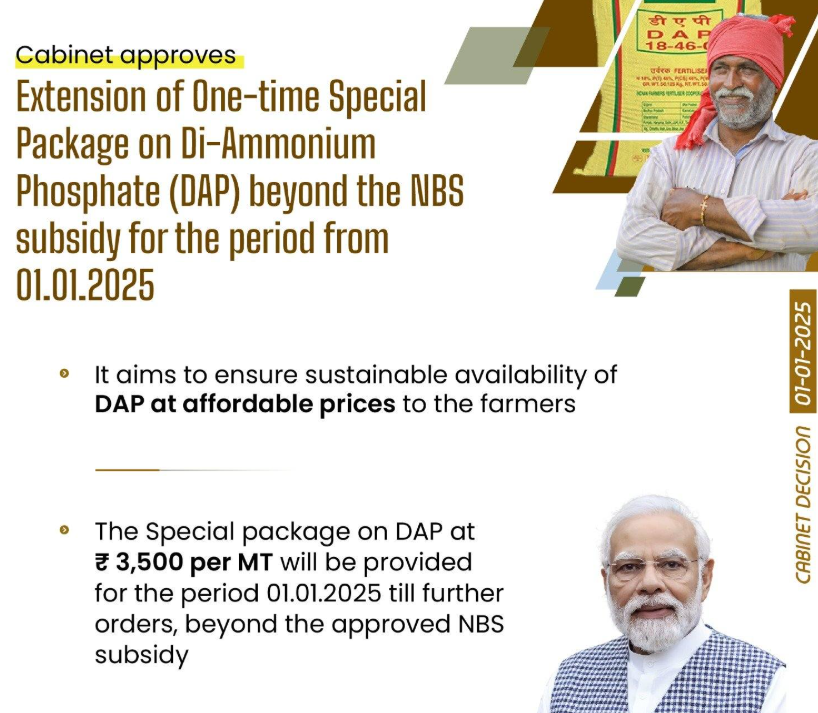
About Fertilizer subsidy in India
- It is financial support provided by the government to make fertilizers affordable for farmers, especially small and marginal ones.
- Fertilizers are essential for enhancing agricultural productivity, but they are costly, so the subsidy helps to reduce the financial burden on farmers.
- The Union Budget for 2024 allocated Rs 164,000 crore for fertilizer subsidy.
Extension of Subsidy on Di-Ammonium Phosphate (DAP)
- The Centre has extended the special subsidy of ₹3,500 per tonne on DAP for one more year starting January 1, 2025.
- Initially set to expire on December 31, 2024, this decision aims to curb farmgate price hikes for India’s second most-used fertiliser.
- This move is particularly significant given the rupee’s depreciation against the US dollar, which adds to cost pressures.
Impact of Fixed Maximum Retail Prices (MRPs)
- Despite DAP and other non-urea fertilisers being decontrolled on paper, the government has informally capped MRPs to shield farmers from price shocks.
- The MRP for DAP remains at ₹1,350 per 50-kg bag, while similar price caps exist for other fertilisers like 20:20:0:13 and muriate of potash.
- However, the steep fall in the rupee, coupled with rising import costs, has made it challenging for fertiliser companies to sustain these price caps.
Economic Pressures on Fertiliser Companies
- The current landed cost of imported DAP stands at ₹54,160 per tonne, significantly higher than the ₹52,960 per tonne recorded three months ago.
- Factoring in additional costs like customs duties, port handling, and dealer margins, the total cost exceeds ₹65,000 per tonne.
- In contrast, the combined government subsidy and MRP yield ₹52,411 per tonne, leaving a considerable gap that makes imports financially unviable without further government intervention.
Government Compensation and Fiscal Cost
- To mitigate industry losses, the government approved full compensation for DAP imports priced above $559.71 per tonne from September 1, 2024, to March 31, 2025.
- However, the subsidy scheme’s effectiveness has been undermined by the rupee’s plunge to ₹85.7-to-the-dollar.
- Extending the ₹3,500 per tonne subsidy reduces the potential fiscal cost, estimated at ₹6,475 crore, and limits the required MRP hike for companies.
Challenges in Fertiliser Availability
- Stock levels of DAP and complex fertilisers, as of mid-December, are lower than last year’s levels.
- The government must ensure sufficient imports of both finished products and raw materials to avoid shortages in the next kharif season.
- Failure to secure adequate supplies could disrupt agricultural productivity.
In conclusion, while the subsidy extension alleviates some immediate pressures, long-term challenges like exchange rate volatility, import viability, and stock replenishment remain critical for stabilising the fertiliser sector.
| About Di-Ammonium Phosphate (DAP) |
|
| Practice Question: How can the government ensure that the fertilizer subsidy program remains environmentally sustainable while supporting the economic needs of farmers? (150 Words /10 marks) |
Prelims Facts
1. RTO official’s Mongolia trip to click Pallas’s cat find its way into textbook
(Source – The Hindu, International Edition – Page No. – 3)
| Context |
|
Species in news:
Pallas’s Cat
- Small wildcat species native to Central Asia.
- Known for its dense, silvery-grey fur and flat face with rounded ears.
- Lives in rocky steppes and cold deserts, at altitudes of up to 5,000 meters.
- Solitary and elusive, active mainly at night (nocturnal).
- Feeds on small mammals, birds, and insects.
- Conservation status: Near Threatened (IUCN Red List), due to habitat loss and hunting.

Bactrian Camel
- Double-humped camels adapted to the cold deserts of Central Asia.
- Can survive extreme temperatures, from -40°C to 40°C.
- Known for thick fur, storing fat in humps for energy.
- Domesticated species used for transport, milk, and wool.
- Wild Bactrian camels are critically endangered.
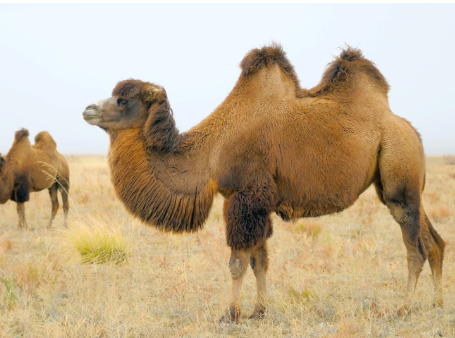
Przewalski’s Horse
- Endangered wild horse, native to Central Asia’s steppes.
- Stocky build with a short mane and no forelock.
- Last truly wild horse species; reintroduced into the wild after near extinction.
- Lives in grasslands and desert edges, feeding on grasses.
- Conservation efforts focus on captive breeding and rewilding programs.
- Conservation status: Endangered(IUCN Red List)
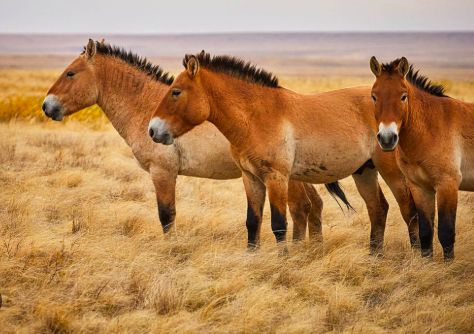
2. Indian researchers develop injectable hydrogel for targeted cancer treatment
(Source – The Hindu, International Edition – Page No. – 6)
| Context |
|
Analysis of the news:
- The hydrogel is designed to deliver anti-cancer drugs directly to the tumor site, reducing the systemic side effects commonly associated with chemotherapy.
- It is composed of ultra-short peptides that remain insoluble in biological fluids, ensuring the hydrogel stays localized at the injection site.
- The hydrogel responds to elevated levels of glutathione (GSH), a molecule found in high concentrations in tumors.
- It releases the drugs in a controlled manner, targeting the tumor while sparing healthy cells from damage.
- This innovation is expected to revolutionize breast cancer therapy by offering more precise treatment.
- The findings were published in the journal Materials Horizons by the Royal Society of Chemistry.

3. Why has Trump called the Panama treaty ‘foolish’?
(Source – The Hindu, International Edition – Page No. – 10)
| Context |
|
Panama Canal Treaty (Torrijos-Carter Treaties, 1977):
- Signed: September 7, 1977, between the U.S. and Panama.
- Main Provisions:
- Transfer of Control: The U.S. agreed to transfer full control of the Panama Canal to Panama by December 31, 1999.
- Canal Zone: The U.S. relinquished control of the Panama Canal Zone, which had been under U.S. sovereignty since 1903.
- U.S. Rights: The U.S. retained the right to intervene militarily to defend the neutrality of the canal under the Permanent Neutrality Treaty.
- Operation and Management: Panama took full responsibility for operating, managing, and maintaining the canal after the transition.
- Neutrality Clause: The Panama Canal was declared neutral, ensuring access for ships of all nations without discrimination.
- Completion: The transition occurred on December 31, 1999.
4. Uttarakhand Launches Winter Char Dham Circuit: Boosting Tourism Amid Environmental Concerns
(Source – Indian Express, Section – Explained- Page No. – 16)
| Context |
|
Analysis of the news:
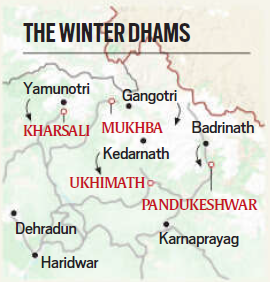
Introduction to Winter Char Dham
- The Uttarakhand government has launched the winter Char Dham circuit to attract pilgrims and tourists during the off-season.
- This initiative focuses on the winter seats of the four sacred Hindu shrines—Gangotri, Yamunotri, Kedarnath, and Badrinath—which shift to lower-altitude temples during the snow-laden months.
- Early figures show moderate success, with 15,314 pilgrims visiting the winter sites by late December.
Economic Significance of Winter Tourism
- Char Dham pilgrimage significantly drives Uttarakhand’s economy, generating over ₹200 crore daily during the peak season.
- The government aims to extend this economic benefit into winter by promoting lesser-known destinations around the winter shrines and capitalizing on the appeal of “sun tourism” during North India’s smoggy winters.
Environmental and Management Concerns
While the initiative has potential economic benefits, environmentalists and activists highlight pressing concerns:
- Overcrowding and Degradation: Increased footfall risks straining fragile mountain ecosystems, degrading infrastructure, and disrupting the sanctity of sacred sites.
- Wildlife Disturbance: Winter tourism may disturb shy and rare species, like snow leopards and mountain sheep, which migrate to lower altitudes for food.
- Safety and Sustainability: The harsh terrain and weather conditions necessitate robust safety measures and sustainable management practices.
Way Forward
To ensure success and sustainability, the state must address environmental concerns by:
- Conducting a comprehensive carrying capacity study.
- Enforcing strict regulations to prevent ecological harm.
- Promoting eco-friendly infrastructure and responsible tourism practices.
Balanced implementation can help Uttarakhand boost its winter tourism while preserving its ecological and cultural heritage.
5. Air India Introduces In-Flight Wi-Fi: A First for Domestic Airlines in India
(Source – Indian Express, Section – Explained- Page No. – 16)
| Context |
|
Analysis of the news:
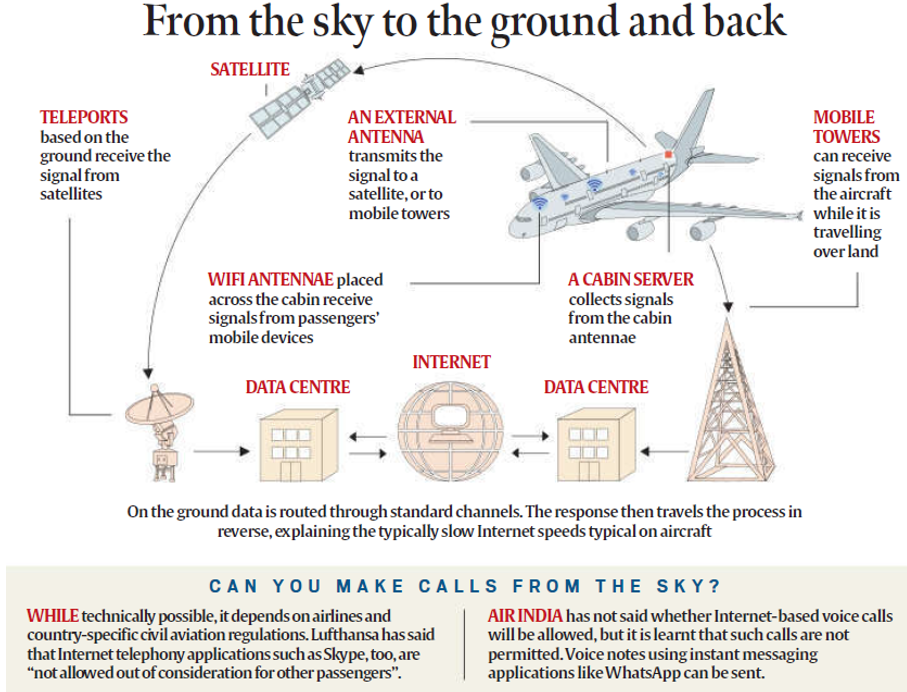
Technologies Behind In-Flight Connectivity
In-flight Internet relies on two main technologies:
- Air-to-Ground (ATG): Uses cellular towers on the ground to transmit signals, effective over land but limited over large water bodies or remote areas.
- Satellite-Based: Transmits signals via satellites, offering broader coverage and reliability, especially over remote regions or oceans.
Both systems require specialized antennae and equipment, with satellite-based connectivity being the preferred choice for global coverage.
Cost Implications
- Installing Wi-Fi equipment is a significant expense for airlines, especially when retrofitting older planes.
- While Air India is currently offering free Wi-Fi, this may change as airlines globally often charge for such services or provide them as perks for premium passengers.
- For Air India, the service could eventually become a source of ancillary revenue.
Future Prospects
- As demand for in-flight connectivity grows, Air India’s initiative marks a step toward modernizing its fleet and improving passenger satisfaction.
- However, challenges such as high costs, slower speeds compared to ground networks, and potential pricing strategies remain critical considerations for long-term implementation.
6. Annual Ground Water Quality Report, 2024
| Context |
|
Analysis of the news:
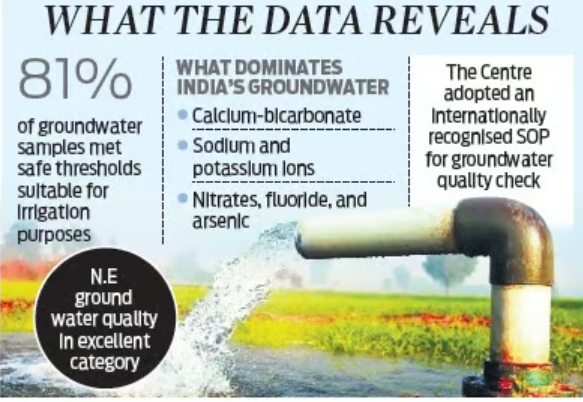
Key Highlights
- Groundwater Extraction: The report states that the degree of groundwater extraction across India is 60.4%.
- Safe Blocks: Approximately 73% of the analysed blocks fall within the ‘safe’ category, indicating adequate replenishment of groundwater resources.
- Nitrate Pollution: There are 440 districts with excessive nitrates in their groundwater as of 2023.
- Rajasthan (49%), Karnataka (48%), and Tamil Nadu (37%) reported the highest levels of nitrate contamination.
- The report identifies uranium contamination, particularly in Rajasthan and Punjab, where the highest numbers of samples exceeded 100 ppb (parts per billion).
- Fluoride contamination is a major concern in states such as Rajasthan, Haryana, Karnataka, Andhra Pradesh, and Telangana.
Reasons for groundwater contamination
- Excessive Use of Fertilizers: Over-reliance on nitrogen-based synthetic fertilizers in agriculture leads to nitrate leaching into groundwater.
- Industrial Effluents: Discharge of untreated or inadequately treated industrial waste introduces heavy metals and other toxic substances into groundwater.
- Geological formations in some regions release naturally occurring contaminants like arsenic, fluoride, and uranium into groundwater.
- Excessive extraction lowers water tables, concentrating naturally occurring contaminants like arsenic, uranium, and fluoride.
Government Initiatives
- National Aquifer Mapping Programme (NAQUIM) to delineate and characterize the aquifer system in the country.
- National Rural Drinking Water Programme (NRDWP): Addressing contaminants such as fluoride and arsenic through water treatment plants and alternate water supply solutions.
- Jal Kranti Abhiyan, aimed at consolidating water conservation and management initiatives in the country through a holistic and integrated approach involving all stakeholders.
- Atal Bhujal Yojana, was launched to improve groundwater management in priority areas with critical and overexploited blocks.
Namami Gange Program: Clean and rejuvenate the Ganga River Basin, including the mitigation of groundwater contamination in adjacent regions.



